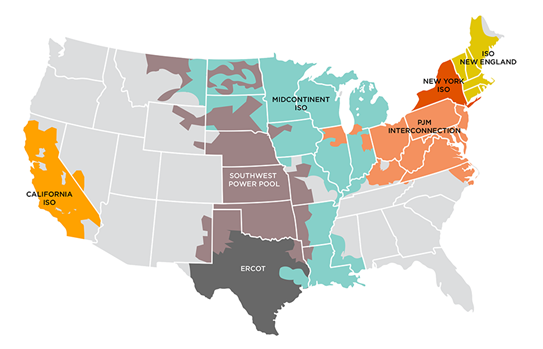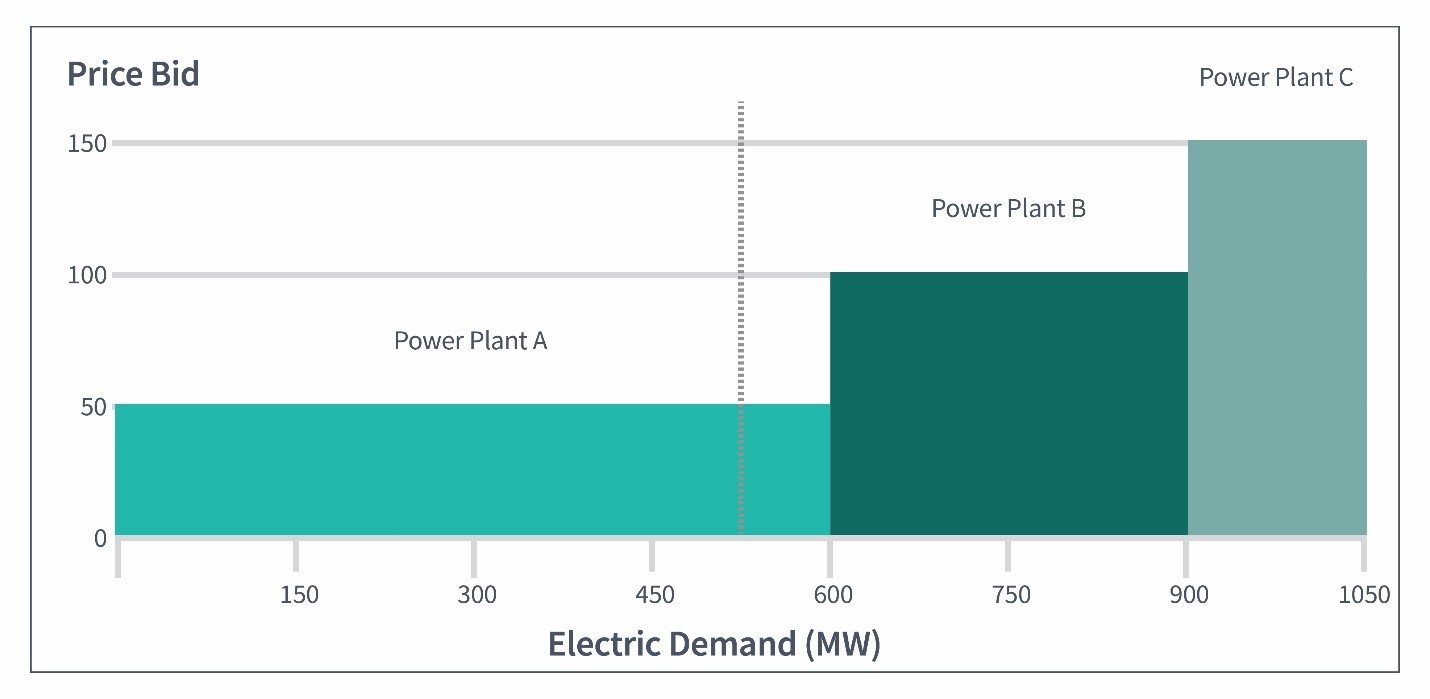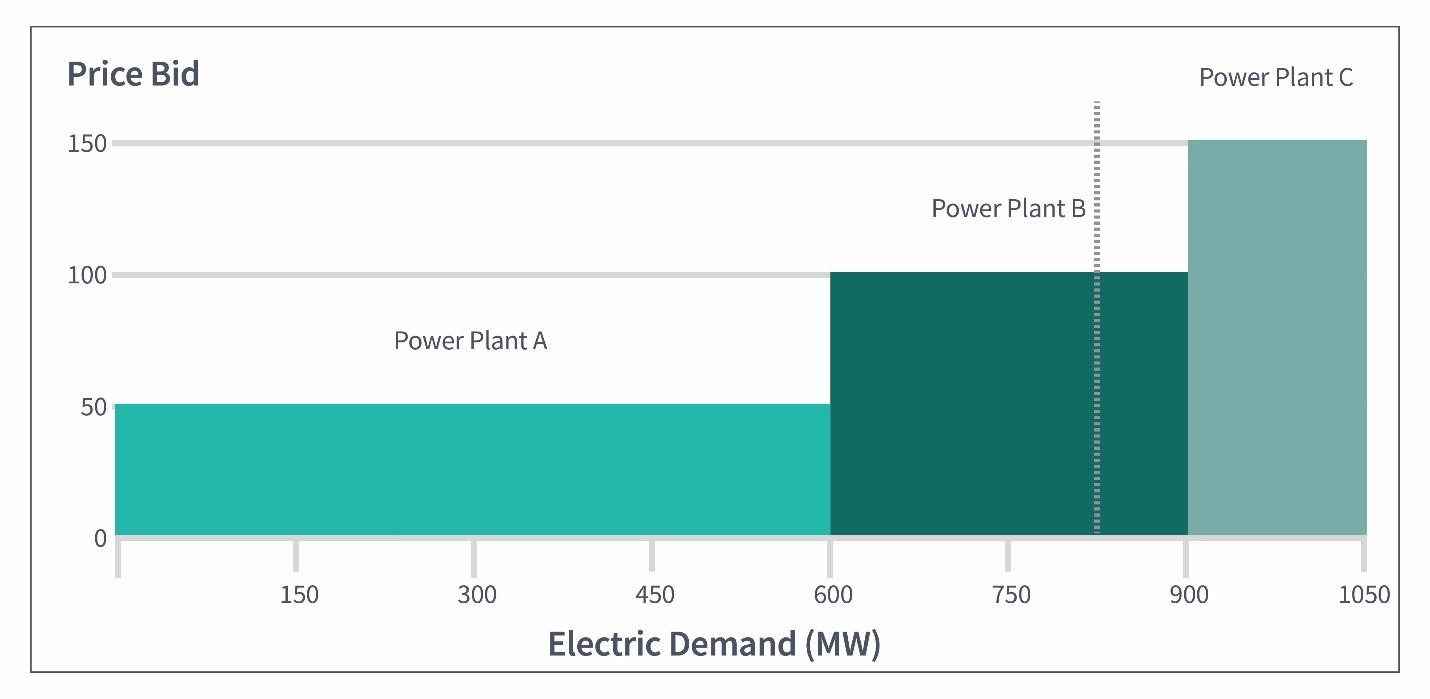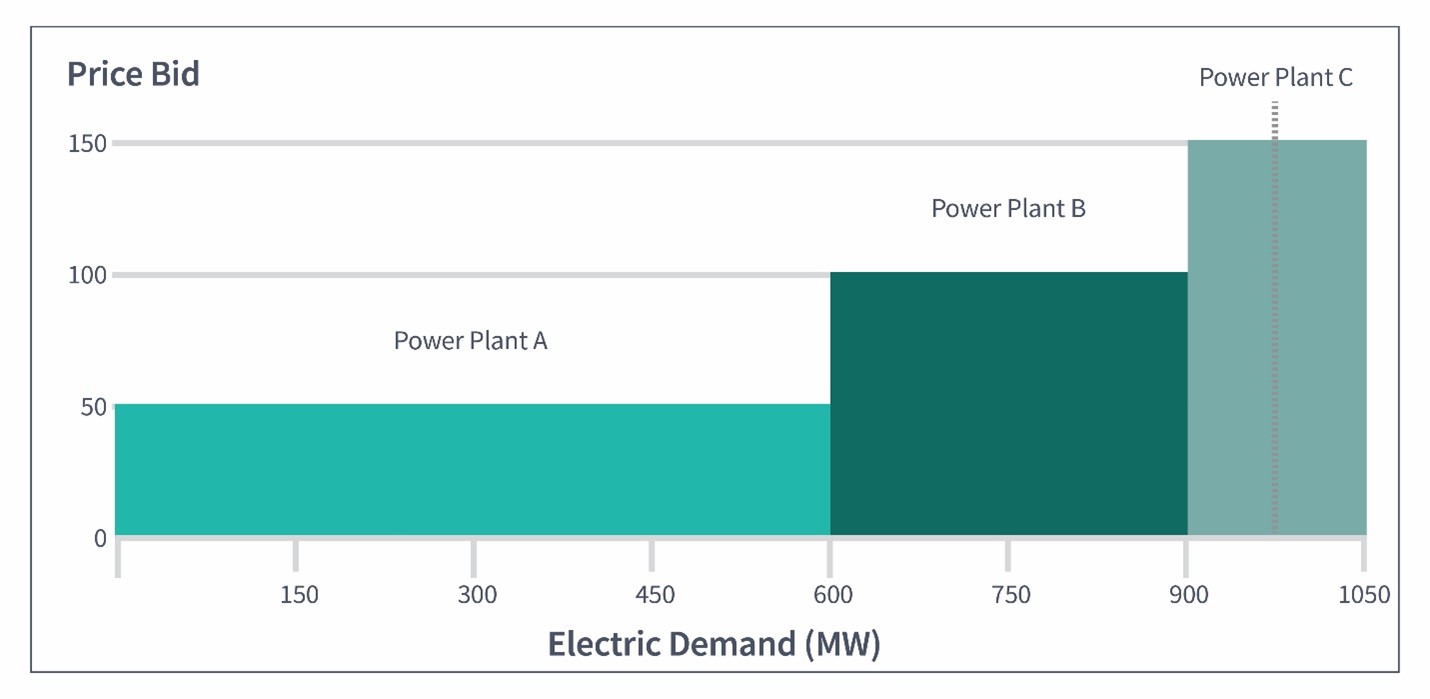This short guide discusses the basics of wholesale electricity markets regulated by the Federal Energy Regulatory Commission (FERC or Commission). The Office of Public Participation (OPP) at FERC developed this guide to promote understanding and participation in FERC matters relating to electricity markets.
You may have heard about wholesale electricity markets when following the news about electricity price changes, power plant development or retirements, or an electric reliability issue in your area. This guide provides you information about these markets and how to find out more. You may be interested in participating in a FERC proceeding related to wholesale electricity markets. OPP would be glad to assist you and we provide contact information for the office at the end of this guide.
Note: The markets covering most of Texas (ERCOT) shown in the map are not overseen by FERC.
Background
When you buy electricity from your utility, that utility had to either (i) produce the electricity, or (ii) purchase it from power plants or other power supply resources. FERC typically has jurisdiction over sales of electricity between power suppliers and utilities, which are called “wholesale sales.” In major parts of the country (see map above), there are organized markets for wholesale electricity sales. FERC has oversight over these markets as well. FERC does not have authority over your electricity purchases; those purchases, often called “retail” transactions, are overseen by your state and local regulators.
The territories shown in the above map are where a regional transmission organization (RTO) or independent system operator (ISO, together, RTOs/ISOs) operates and runs the electric transmission grid. Collectively, RTOs/ISOs (i) manage the day-to-day electricity transmission needs for 190 million people and (ii) plan for the long-term needs of the electric power system in those areas, while (iii) running the wholesale electricity markets that are the subject of this guide. Six FERC-regulated RTOs/ISOs exist in the United States[i]:
- PJM Interconnection (PJM)[ii]
- Midcontinent ISO (MISO)[iii]
- California ISO (CAISO)
- Southwest Power Pool (SPP)[iv]
- New York ISO (NYISO)
- ISO-New England (ISO-NE)[v],[vi]
FERC regulates RTOs/ISOs via electricity market proceedings. FERC proceedings affecting RTOs/ISOs may be started for several reasons, including when: (i) there is a proposed change to the RTO/ISO market rules; (ii) there is a proposed change to FERC regulations that may impact markets in one or more RTO/ISO territories, or (iii) there is a complaint about unjust or unreasonable rates. All of these proceedings provide opportunities for public input.
Another regional grid operator shown on the map, Electric Reliability Council of Texas (ERCOT), has electricity markets that are not subject to FERC jurisdiction.[vii] Instead, ERCOT is subject to state-level oversight by the Public Utility Commission of Texas and the Texas Legislature.
Electricity Markets
There are two basic types of electric energy markets common to each RTO/ISO: a “day-ahead energy market” and a “real-time energy market.”
In the day-ahead electric energy market, the RTO/ISO schedules electricity production to meet forecasted demand one day in advance. Supply and demand forecasts are influenced by many factors, including weather, the day of the week, and planned power plant outages. For example, predicted high temperatures will likely result in higher usage from air conditioning.
The day-ahead approach gives power plant owners and other suppliers time to plan (as large plants need to be started up well in advance of production) and make any necessary fuel arrangements. It also provides the RTO/ISO time to prepare for electric transmission line congestion – power lines overloaded with too much electric power (heavy “traffic”), which can create physical and safety limits on the ability to move more power. The majority of energy market transactions take place in the day-ahead market rather than the real-time market, which is discussed next.
Through the real-time electric energy market, the RTO/ISO adjusts to system conditions within short intervals, frequently between 5 and 15 minutes. These differences may arise from issues such as unplanned outages of power plants, unexpected levels of congestion on electric transmission lines, or increased demand for electricity due to weather. To avoid a shortfall of energy supply in real-time, the RTO seeks electricity for immediate delivery from power suppliers that have the ability to increase their supply.
In addition to the day-ahead and real-time electric energy markets, four of the RTO/ISOs (ISO-New England, ISO-New York, MISO, and the PJM Interconnection) also have a centralized capacity market. A capacity market aims to increase grid reliability by seeking commitments from power suppliers to meet future electricity needs (how much ahead of time depends on the RTO, but it can be as much as three years). Rather than paying power suppliers directly for the energy they produce, a capacity market pays a power plant or other resource for its ability to produce power should it be required. For example, if a company operates a 1,000 MW nuclear plant, it will receive a payment for making the plant available to provide electricity if needed at a specified time in the future (that is, providing capacity), separate and in addition to the payment for any electricity that it generates.
Lastly, there are also markets for ancillary services, specific products that help the electric grid remain operative and functioning reliably. These products can include energy reserves when the need for energy is most urgent, voltage support, and other products that meet the technical needs of the grid.
Functions of Electricity Markets
Electricity markets exist to facilitate the reliable and efficient allocation of power production and transmission. These markets also serve a variety of functions in RTO/ISO areas including:
- A cost recovery function. Markets allow power plants and other power resources that are (i) located in a useful place for serving electric demand, and that (ii) operate when needed, to recover their operating costs and to earn a reasonable profit so that they will want to remain in the business of providing electricity;
- A resource allocation function. Electricity markets set prices, based on supply-and-demand principles, that can signal that a certain area needs more power resources, or that power resources of a certain type are particularly profitable, or that it is time for an inefficient or uneconomic power plant to retire. One of the central goals of electricity markets has been to spur such investment and retirement decisions;
- A reliability function. Prices set by markets work to ensure that there are enough power resources to maintain the reliable and efficient transmission of electricity and help to avoid disruptions in electric service;
- A technological integration function. Through effective market rules, markets can help foster the integration of additional power resources and more efficient electricity technologies, such as electricity storage, demand response (committing to use less power at key times), energy efficiency products, behind-the-meter renewable energy, and other resources;[viii] and
- A competition function. Markets allow power resources to compete to provide consumers with the lowest-cost power consistent with system needs. However, as with all competition, safeguards must be implemented to ensure that the competition is just and results in reasonable rates.
A Word on Market Design -- the “Single Clearing Price” Approach
Electricity and capacity markets utilize “auctions” and market rules. Auctions can help answer the key questions that a market must address: who produces your electricity, and at what prices? While auctions can vary in design and complexity, the “single clearing price” auction is a commonly used design. Under a single clearing price approach, the RTO/ISO rejects bids for prices that are higher than necessary to meet a need, but the highest-priced resource that is needed sets the price for everyone.
To provide an example using a small number of bids, let us suppose that we are dealing with an electric energy market that needs to meet a 500 MW demand in a given hour, and that has three power plants available in the area to meet the demand: Power Plant A, a 600-MW power plant that has relatively low operating costs, Power Plant B,a 300-MW power plant with average operating costs, and Power Plant C, a 150-MW plant that has high operating costs.
To meet expected market needs, Power Plant A bids $50 to provide electricity in a given hour, Power Plant B bids $100, and Power Plant C bids $150. Here is a graphical depiction of what is going on.
You can see that Power Plant A, a 600 MW plant, can cover the first 600 MW of demand at price of $50. The steady demand of 500 MW in this example is shown by the vertical dotted line. In this case, the RTO/ISO would call on low-cost Power Plant A to produce all the necessary power, and inform Power Plants B and C that they are not needed. Power Plant A would run and get its bid of $50 per megawatt-hour. The clearing price in this case is set by Power Plant A at $50 per megawatt-hour.
Now, let’s say that Power Plants A, B, and C keep their bids to provide electricity in a subsequent hour at the same levels but demand climbs to a steady 825 MW. This is depicted as follows:
So, now, the RTO needs to call on Power Plants A and B to operate to meet the demand of 825 megawatts (vertical dotted line), but Power Plant C will not be called on, as it is not needed and too expensive. In this situation, Power Plant B sets the clearing price for both itself and Power Plant A at $100. Power Plant A was willing to accept $50, but in a single clearing price market Power Plants A and B would both get $100 per megawatt-hour for their output.
For a final example, let’s consider a high demand scenario with the same bids from Power Plants A, B, and C.
In this example, demand is about a steady 975 megawatts for the hour (vertical dotted line), so all three plants (A, B, and C) are now needed. Power Plant C sets the single clearing price for all three plants at $150 per megawatt-hour in this example. All three plants would receive $150 per megawatt-hour for their output.
You may be questioning why Power Plant A was paid more than its bid in the last two examples, as well as why Power Plant B was paid more than its bid in the final example. There are economic justifications for those outcomes, but not everyone accepts their validity in all circumstances. One basic justification offered is that this approach would encourage the development of more plants with low operating costs, which could in the long run lead to lower prices for everyone. OPP would be happy to discuss single clearing price markets with you further and can point you to additional resources such as FERC’s 2020 Energy Primer: A Handbook of Energy Market Basics.[ix]
To Learn More
Please contact OPP by e-mail at [email protected] or by phone at (202) 502-6595, or please see our website at www.FERC.gov/OPP for additional information and resources. OPP has posted numerous guidance documents on electric markets and related topics at https://www.ferc.gov/energy-markets-0.
[i] There are also wholesale electricity sales outside of the RTO/ISO territories, and FERC or its predecessor has also regulated those sales since 1935. This explainer focuses on the RTO/ISO territories and their markets, but OPP would also be happy to discuss any concerns or questions you have on non-RTO/ISO areas. There are also markets developing in non-RTO areas, such as the Western Energy Imbalance Market in non-RTO portions of the West and Northwest.
[ii] PJM manages the electric grid for all or part of Pennsylvania, New Jersey, Maryland, Delaware, Ohio, Michigan, Illinois, Indiana, Virginia, West Virginia, North Carolina, Kentucky, a small part of Tennessee, along with the District of Columbia.
[iii] MISO manages the electric grid for all or part of Montana, North Dakota, South Dakota, Minnesota, Iowa, Wisconsin, Michigan, Indiana, Illinois, Missouri, Kentucky, Arkansas, Mississippi, Louisiana, and Texas.
[iv] SPP manages the electric grid for all or part of Arkansas, Iowa, Kansas, Louisiana, Minnesota, Missouri, Montana, Nebraska, New Mexico, North Dakota, Oklahoma, South Dakota, Texas, and Wyoming.
[v] OPP is developing explainers on participation in RTOs/ISO stakeholder proceedings and posting them at www.ferc.gov/opp
[vi] ISO-New England manages the electric grid for all or part of Connecticut, Massachusetts, Rhode Island, Vermont, New Hampshire, and Maine.
[vii] ERCOT is not subject to federal (FERC) jurisdiction because its grid is not connected to those of other states. Thus, power sales in ERCOT are not considered sales in interstate commerce and not subject to federal (FERC) oversight. That said, ERCOT runs some electricity markets that have similarities to those described herein.
[viii] See, e.g., FERC Order No. 2222. Participation of Distributed Energy Res. Aggregations in Mkts. Operated by Reg’l Transmission Orgs. & Indep. Sys. Operators, Order No. 2222, 172 FERC ¶ 61,247 (2020), order on reh’g, Order No. 2222-A, 174 FERC ¶ 61,197 (2021), order on reh’g, Order No. 2222-B, 175 FERC ¶ 61,227 (2021).




